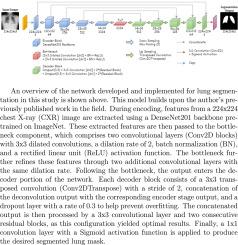基于改进U-Net的胸部x线图像鲁棒肺分割
Computer methods and programs in biomedicine update
Pub Date : 2025-01-01
DOI:10.1016/j.cmpbup.2025.100211
引用次数: 0
摘要
世界卫生组织(世卫组织)的统计数据证明,肺部疾病仍然是全世界死亡的主要原因。放射科医生解释胸部x光片(CXR)图像以诊断常见肺部疾病的有限可用性构成了重大挑战,经常导致诊断和治疗延迟。因此,可以使用计算机辅助诊断(CAD)工具来简化和加快诊断过程。最近,深度学习技术在CXR图像的自动分析中获得了突出的地位,特别是在分割肺区域作为关键的初步步骤方面。本研究旨在开发和评估一个基于改进U-Net架构的肺分割模型。该架构利用了DenseNet201的迁移学习等技术,作为扩展卷积和残差块的特征提取器。我们进行了一项消融研究,以评估这些架构组件,以及其他元素,如增强数据、替代主干和注意机制。在蒙哥马利县(MC)和深圳医院(SH)两个公开可用的数据集上进行了大量广泛的实验,以验证这些技术在分割性能方面的有效性。该模型在MC数据集上的表现优于其他最先进的方法,其Jaccard Index (IoU)为97.77,Dice Similarity Coefficient (DSC)为98.87。这些结果表明,与基线U-Net相比,IoU和DSC分别增加了3.37%和1.75%。这些发现强调了基于深度学习的肺分割模型的架构增强的重要性,有助于更有效、准确和可靠的肺部疾病评估CAD系统。本文章由计算机程序翻译,如有差异,请以英文原文为准。

Robust lung segmentation in Chest X-ray images using modified U-Net with deeper network and residual blocks
Lung diseases remain a leading cause of mortality worldwide, as evidenced by statistics from the World Health Organization (WHO). The limited availability of radiologists to interpret Chest X-ray (CXR) images for diagnosing common lung conditions poses a significant challenge, often resulting in delayed diagnosis and treatment. In response, Computer-Aided Diagnostic (CAD) tools can be used to potentially streamline and expedite the diagnostic process. Recently, deep learning techniques have gained prominence in the automated analysis of CXR images, particularly in segmenting lung regions as a critical preliminary step. This study aims to develop and evaluate a lung segmentation model based on a modified U-Net architecture. The architecture leverages techniques such as transfer learning with DenseNet201 as a feature extractor alongside dilated convolutions and residual blocks. An ablation study was conducted to evaluate these architectural components, along with additional elements like augmented data, alternative backbones, and attention mechanisms. Numerous and extensive experiments were performed on two publicly available datasets, the Montgomery County (MC) and Shenzhen Hospital (SH) datasets, to validate the efficacy of these techniques on segmentation performance. Outperforming other state-of-the-art methods on the MC dataset, the proposed model achieved a Jaccard Index (IoU) of 97.77 and a Dice Similarity Coefficient (DSC) of 98.87. These results represent a significant improvement over the baseline U-Net, with gains of 3.37% and 1.75% in IoU and DSC, respectively. These findings highlight the importance of architectural enhancements in deep learning-based lung segmentation models, contributing to more efficient, accurate, and reliable CAD systems for lung disease assessment.
求助全文
通过发布文献求助,成功后即可免费获取论文全文。
去求助
来源期刊

Computer methods and programs in biomedicine update
Health Informatics
CiteScore
5.90
自引率
0.00%
发文量
0
审稿时长
10 weeks
 求助内容:
求助内容: 应助结果提醒方式:
应助结果提醒方式:


